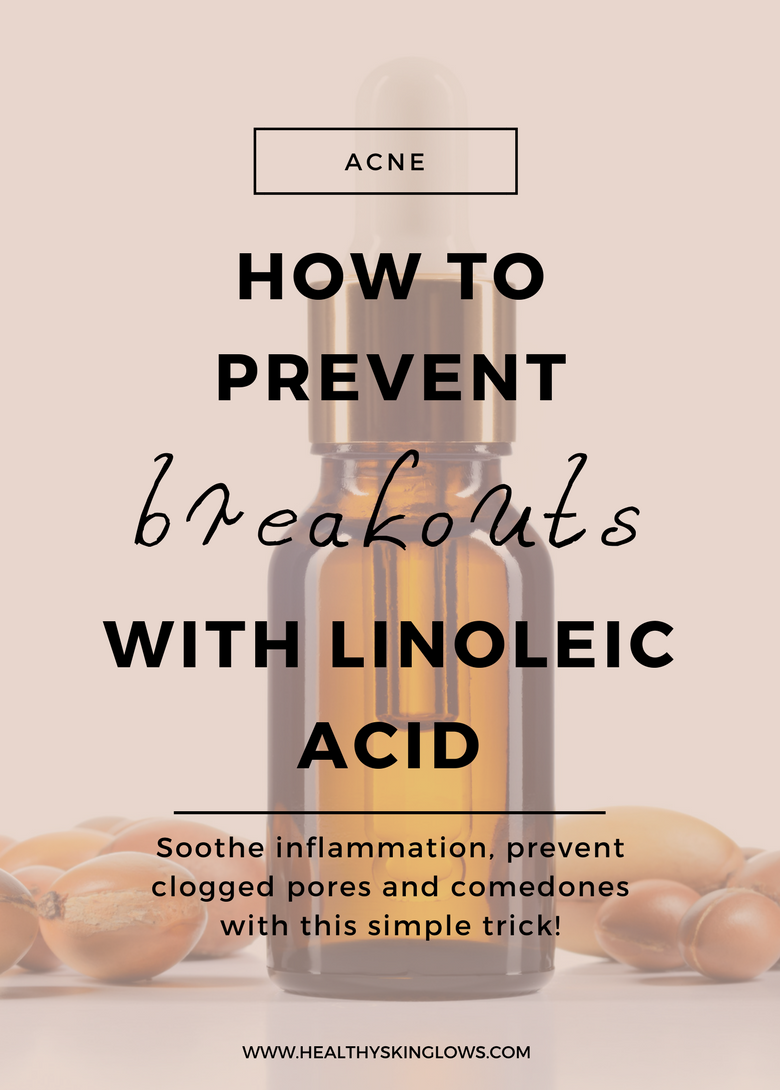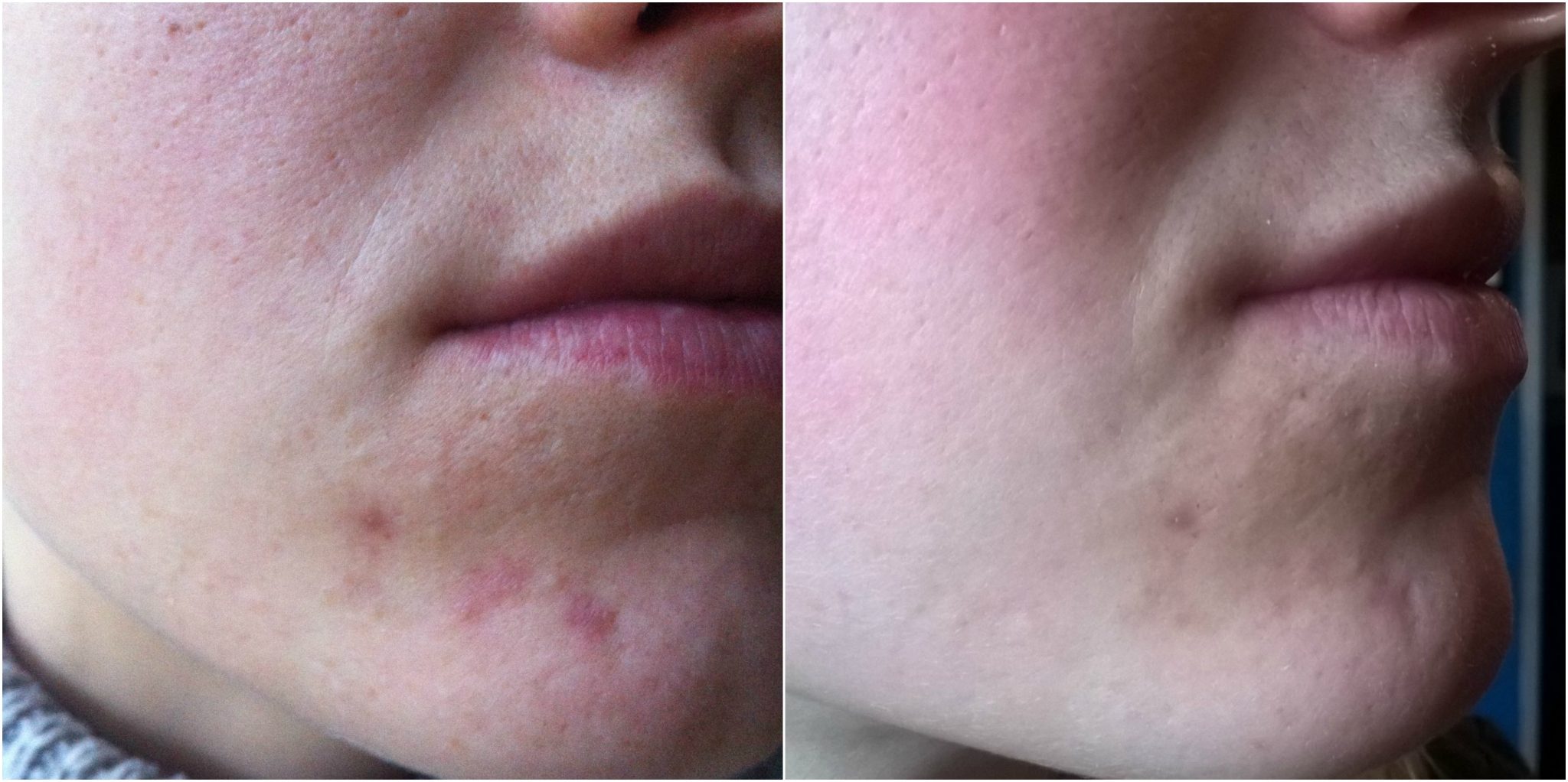
When I was desperately trying to clear up my skin years ago, I could feel that something wasn’t working.
What was I missing?
I was doing everything right, and followed the dermatologist’s instructions to the T. So why was my skin getting more tired, dull, and new acne appearing nearly every morning?
I just couldn’t figure it out.
Then I finally decided to take matters into my own hands and dug into the scientific literature.
What I quickly found was a nearly 30-year old study showing that acne-prone skin is deficient in an essential fatty acid. Why was I only seeing this now and what did it really mean?!
Little did I know that this information would eventually change my skin forever, and, quite literally, my life.
THE DEFICIENCY OF ACNE-PRONE SKIN YOU NEED TO CORRECT TO HAVE CLEAR SKIN
Acne-prone skin, especially oily acne-prone skin, is deficient in an essential fatty acid called linoleic acid (source).
Linoleic acid is a vital component of sebum – oil your skin produces that coats your skin. This deficiency indirectly clogs your pores and leads to acne and breakouts.
Bringing back the extra linoleic acid to your skin is very healing and will also help to prevent future breakouts and acne.
Deficiency usually occurs when too much sebum is produced – resulting in oily skin, and the sebum producing cells in your skin produce this extra sebum with oleic acid instead (diluting the linoleic acid content).
This is a problem because the lack of linoleic acid triggers pore-clogging processes:
1. An increase in a pro-inflammatory factor called interleukin 1 alpha (IL-1alpha) – a cytokine shown to play a very important role in acne development
2. An increase in IL-1alpha triggers hyperkeratinization, which causes clogged pores – the first stage of acne!
HOW TO PREVENT CLOGGED PORES (THE BEGINNING OF ACNE)
When dead skin cells lining the inside of a pore accumulate too much of a protein called keratin, they stick together too much, which is called hyperkeratinization.
When the pores are clogged in this way, excess sebum keeps building up, creating a plug in your pore. Due to the absence of oxygen, clogged pores are a perfect environment for bacterial growth (acne bacteria P.acnes is anaerobic), which leads to inflammation.
Clogged pores + inflammation equals red, painful acne spot!
Hyperkeratinization is affected by hormones (which are also affected by our diet and lifestyle), and some are more prone to it than others, thanks to our genes.
Simply washing your face morning and evening will not make the deficiency go away.
It will just make it worse because too frequent washing dehydrates the skin, and then the skin produces even more oil to compensate, further diluting the linoleic acid content, and aggravating acne.
Yes, you read that right, those foaming cleansers ‘suited’ for acne-prone skin actually make acne worse!
Supplying linoleic acid to the skin helps to correct the linoleic acid deficiency in the sebum.
Without the deficiency, the amount of IL-1alpha is reduced, and the pore-clogging hyperkeratinization process is slowed down (or stopped), reducing the clogged pores and comedones.
In fact, researchers have found a reduction in comedones (which develop from clogged pores) by 25% in just one month of applying linoleic acid topically (source)! Now imagine what happens when you continue using high-linoleic acid oils for several months!
But where do we find linoleic acid? Glad you asked!
Linoleic acid is naturally found in plant-based oils in high concentrations, including hemp seed, grape seed, and rosehip seed oil.
REDUCING EXCESSIVE SEBUM PRODUCTION HELPS TO PREVENT ACNE
If the skin produces too much sebum, the situation is even worse, because the extra sebum is made with oleic acid, not linoleic acid. This makes the linoleic acid deficiency worse.
Reducing the sebum production is, therefore, a very effective means of preventing acne and breakouts. In fact, the most powerful acne drug on the planet, isotretinoin (active substance in Accutane and Roaccutane), works by killing the sebum-producing cells.
So what causes oily skin?
Hormones are the cause of oily skin, mainly androgens (male hormones, but both men and women have them).
Conversion of testosterone to the very potent dihydrotestosterone (DHT) in the skin is particularly important here because DHT puts the sebum production into overdrive. There is a special enzyme doing the conversion. It’s called 5-alpha reductase.

There are some known 5-alpha reductase inhibitors – they prevent the action of the 5-alpha reductase, so we end up with less DHT and less sebum.

Among the known inhibitors are essential fatty acids like gamma-linolenic acid (GLA), linoleic acid (LA), alpha-linolenic acid (ALA) and the mineral zinc.
Plant-based oils rich in linoleic acid can, therefore, act as 5-alpha reductase inhibitors.
When using oils rich in linoleic acid, make sure to use those that also have very little oleic acid to avoid clogging of the pores (oleic acid itself is comedogenic).

What’s more, linoleic acid has powerful anti-inflammatory properties (source). Actually, the lack of linoleic acid causes too much inflammation, and supplying linoleic acid to the skin calms down inflammation pretty quickly!
LINOLEIC ACID ACTS CLOSER TO THE ROOT CAUSE OF ACNE
Common anti-acne ingredients such as salicylic acid or benzoyl peroxide are (temporarily) effective because they ‘unclog’ the pores, helping to shed off those dead skin cells that could clog the pores.
However, this is merely a time race with your skin, which you are probably not going to win in the long run.
Linoleic acid acts closer to the root causes of clogged pores than other over-the-counter acne treatments by decreasing both sebum production and hyperkeratinization process.
And remember, that means less clogged pores and less acne!
SUMMARY
- Sebum of acne-prone skin is deficient in linoleic acid – a vital component of sebum that affects its quality
- The deficiency increases the level of a pro-inflammatory molecule (cytokine IL-1alpha), which induces hyperkeratinization and clogs the pores
- Clogged pores set the perfect stage for acne development
- Linoleic acid (among others) inhibits the enzyme that converts testosterone to the potent DHT. We want as little as possible DHT because it triggers pore-clogging hyperkeratinization process
- Linoleic acid has anti-inflammatory and anti-bacterial properties, which also helps with acne
- Applying plant-based oils high in linoleic acid helps correct linoleic acid deficiency, which greatly reduces chances of future acne breakouts. Avoid if your skin doesn’t tolerate oils.
In radiant skin health,
Sara
Questions! Have you used high linoleic acid oils in your skincare routine? Did they help?
REFERENCES
Essential fatty acids and acne – http://www.jaad.org/article/S0190-9622%2886%2970025-X/abstract Sebum analysis of individuals with and without and acne – https://www.ncbi.nlm.nih.gov/pubmed/20436883 Can sebum reduction predict acne outcome? – https://www.ncbi.nlm.nih.gov/pubmed/20518779 The role of facial sebum secretion in acne pathogenesis: facts and controversies – https://www.ncbi.nlm.nih.gov/pubmed/20082943 New developments in our understanding of acne pathogenesis and treatment – https://www.ncbi.nlm.nih.gov/pubmed/19555434
Inhibition of type 1 and type 2 5alpha-reductase activity by free fatty acids – https://www.ncbi.nlm.nih.gov/pubmed/12477490 Inhibition of steroid 5 alpha-reductase by specific aliphatic unsaturated fatty acids – https://www.ncbi.nlm.nih.gov/pubmed/1637346 Inhibition of 5 alpha-reductase activity in human skin by zinc and azelaic acid – https://www.ncbi.nlm.nih.gov/pubmed/3207614


Hi! What do you think about SQUALANE oil as an occlusive?
It’s awesome!:)) Just make sure it agrees with your skin, it doesn’t always! Some people break out.
Hey, i’ve been on Accutane twice by now and everytime i stopped using this drug my acne came back sooner or later. My skin is not producing as much oil as it used to, but it appearently still is enough to get acne breakouts (not as bad as before accutane though). I used sweet almond oil + a few drops of lavender essential oil before going to bed and it cleared my skin for 4 days…then all hell broke loose and my skin started to act just as crazy as before, so i stopped (my dumb ass just found out that almond oil has a high level of oleic acid…yeah i am really dumb hahaha). So closeup my skin looks like a cracked dried out Las Vegas ground…is this also a sign that my skin is lacking linoleic acid or something? My skin is not flakey (except when i use benzoylperoxide, which i am going to stop using now, cause it just dries out my skin and doesn’t prevent new breakouts…it just makes the active ones heal faster…and i am only using 3% bpo…so it’s “realtively” mild…but my whole face just itches…it wasn’t like that before accutane. SOOOOOO I really want to try grapeseed oil, but i am scared that the same thing happens…it helps and then all hell breaks loose… idk if this helps you to understand my skin condition right now…but i would love to kind of get an answer if i should try it or not…is there something like a “purging phase” where you get all the breakouts you could imagine and a few weeks later you have perfectly clear skin or should i stop immediately when i start to break out?
Hi Tony! This sounds like your skin cannot tolerate oils (I have also put a warning for it in the post, not sure if you’ve seen :)). I would say that most of the time there is no purging phase, and when it doesn’t work, no need to push it. You can have a great skincare routine without oils and oil cleansing. Have you taken my free online course where you can learn more? Here: healthyskinglows.com/free-course . Hope this helps!:))